By Frank Iannamico
During World War II, the U.S. Ordnance Department began a research and development program for a new lightweight infantry rifle. After the war ended, progress was slowed due to reduced post-war funding for the project.
Early weapons developed during the program were based on the M1 Garand rifle, which slowly evolved into the T44 series of rifles, ending with the T44E4. One of the more serious competitors facing Springfield Armory’s T44E4 was the Belgian-designed Fusil Automatique Leger or FN FAL rifle.
During 1954, the U.S. placed an order with Fabrique Nationale of Herstal, Belgium, for 3,303 FN FAL rifles in 7.62mm caliber. The weapons were distributed to the using services for testing and evaluation. Although the Belgian-made rifles were marked T48 they were a combination of 2,270 FAL Canadian pattern, 833 semi-automatic light-barrel T48s and 200 heavy-barrel T48E1 models with bipods.
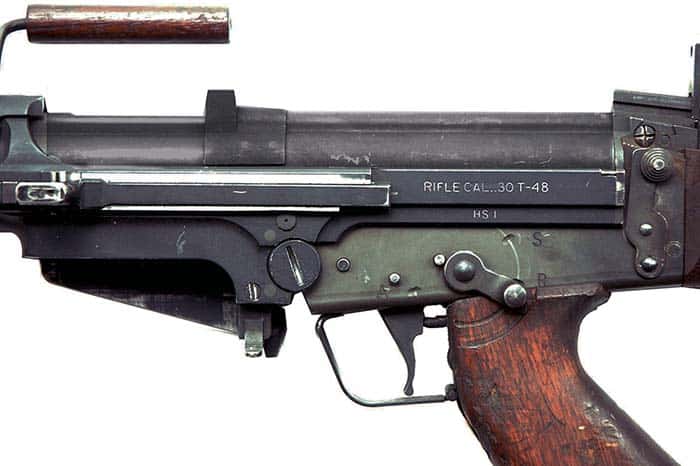
The Inch-Pattern FN FAL
A meeting was held at the Office of the Chief of Ordnance on May 10, 1954, to brief representatives of the Springfield Armory on the policy for the T48 rifle program. On May 26, 1954, Armory officials attended a conference held at the head office of Canadian Arsenals Limited. The group distributed translated drawings and manufacturing data to prospective contractors who were invited to submit bids for production studies. It was established that engineering information would be exchanged between the United States, Great Britain and Canada with Canadian Arsenals Ltd acting as the clearing house. Spare parts requirements for a normal one-year maintenance program were compiled for 500 T48 rifles to be manufactured in the United States.
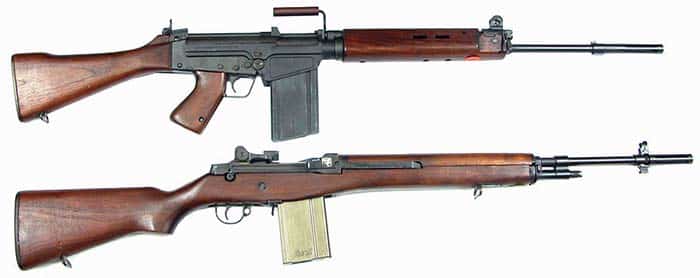
High Standard T48 Rifles
The U.S. Ordnance Department charged the Springfield Armory with the job of converting the FAL rifle from the metric to the Imperial system of inches. After a brief study, it was determined that converting the Belgian drawings to inches would not be an easy task. Other concerns were U.S. Ordnance specifications for materials, heat-treating procedures, manufacturing tolerances and other manufacturing operations. The Springfield Armory was busy with the T44E4 rifles and numerous other projects, so it decided to turn the task over to a commercial entity. Bids were taken for the project, and the contract was eventually awarded to the High Standard Corporation. As part of the agreement, High Standard was to manufacture at least 12 functional FAL T48 rifles from their final drawings to verify the results of their conversion efforts. Canada adopted the inch-pattern FN FAL and assisted High Standard with their drawing conversions from metric into inches. The rifles were to be delivered by September 1954. The High Standard T48s had a uniquely shaped “square” trigger guard, a U.S. specified flash suppressor and a receiver mounted guide for loading the rifle without removing the magazine.

Initial testing found the T48 rifle proving superior to the U.S. T44, and consideration was given to dropping the T44 from the competition. However, outperforming the FN rifles in the arctic testing phase gave the T44 a new lease on life.
T48 rifles made by High Standard along with Springfield Armory’s T44 rifles were tested under arctic conditions during the winters of 1953, 1954 and 1955. The rifles were also concurrently undergoing testing at Fort Benning, Georgia. Results from both locations reported that the T44 rifle was proving superior. Fort Benning reported that the T48 rifles were experiencing functioning problems under dusty conditions. Similar problems were encountered with the FAL rifles during desert testing by Great Britain. To address the problem, a small delegation of Americans who represented the U.S. contractors, visited the Royal Small Arms Factory in England and the Fabrique Nationale factory in Liege, Belgium. The problem was traced to the FAL’s close tolerances between the bolt carrier and the receiver. The Belgium engineers suggested the incorporation of “sand cuts,” or longitudinal grooves, machined into the bolt carriers, which solved the problem.
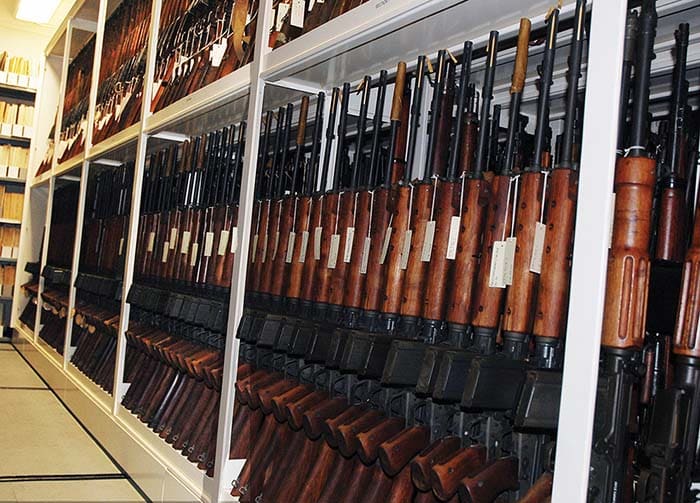
The Harrington and Richardson Arms Company (H&R) and International Harvester both submitted bids to manufacture 500 inch-pattern T48 rifles. Harrington and Richardson was chosen to produce the T48 rifles while the Springfield Armory would manufacture the T44E4 design, as well as the heavy-barrel T44E5 rifles for the trials. The cost to manufacture the inch-pattern T48 rifles was $2,392.00 (1955 dollars) each. The T48s made by H&R differed slightly from those made by High Standard. The High Standard T48s were a straight inch-scale transfer from the FN caliber .30 lightweight drawings. While the H&R-made T48s were patterned after the Canadian prototype C1 models which were essentially inch-corrected Canadian EX1 rifles. The 500 H&R rifles were primarily for production and cost studies. The inch-pattern U.S. version of the FN FAL, designated as the T48 rifle, used the Canadian magazine design that included a reinforced magazine lip. This modification applied to all inch-pattern FAL rifle magazines made the magazines non-interchangeable with metric FN FAL rifles.
The Hand Arms and Equipment Unit of the Armory was ordered to prepare Ordnance drawings, provide manufacturing information and technical data to the Boston Ordnance District for use in administering the contract number DA-19-020-ORD-3436 for the caliber .30 T48 rifle to H&R.
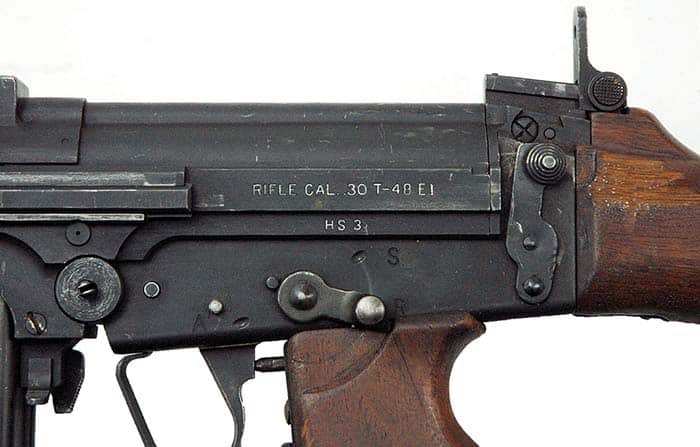
A representative from the Springfield Armory attended a four-day conference held from May 16 through May 20, 1955, at the Royal Small Arms Factory in Enfield, England. The conference initiated by the British government was the first in a series to promote cooperation and eventual tripartite NATO standardization of the Belgian FN rifle.
After the first 100 U.S.-made Harrington and Richardson T48-FAL rifles were ready in September 1955, 10 were randomly selected for testing at the Aberdeen Proving Center. The Harrington and Richardson T48 rifles were initially experiencing a few problems with small parts failing and stoppages. After these problems were addressed and solved, testing resumed. Subsequent trials found that the updated T44E4 rifle had fewer malfunctions than the T48 rifles even after the modification of adding sand cuts to the bolt carriers of the T48. The Harrington and Richardson T48 rifles were unable to qualify in the accuracy test. This problem was traced back to excessive machining tolerances on the barrels, partially because of a drawing error.
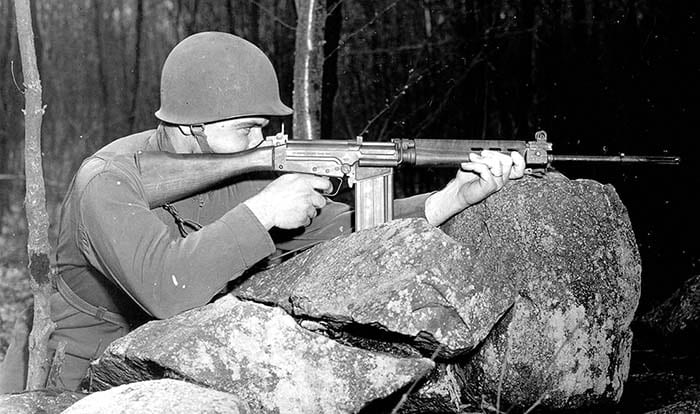
Despite there being no formal contract between Fabrique Nationale and the United States, the company granted the U.S. the complete rights to produce the FN T48 rifle domestically at no cost. There was a catch to the agreement. A royalty would have to be paid on any FN weapons given or sold to another country under a military aid agreement.
After most of the early problems in both rifles had been solved, a final head-to-head, full-scale test between the U.S.-designed T44E4 and the Belgium-designed, U.S.-built T48 rifles was scheduled for the summer of 1956. The stakes were high; it was expected that one of the rifles would be chosen as the new U.S. infantry weapon, replacing the M1 rifle. Tests were administered at both Fort Benning and at the U.S. Marine Corps Base, Quantico, Virginia. There was a great deal of skepticism on behalf of those involved in the testing about the United States Army adopting a foreign-designed infantry weapon for its forces. Many felt that the U.S. was simply going through the motions of testing the FAL rifle to appease Canada, Great Britain and other NATO members, who were pressuring the U.S. to adopt the Belgian FAL rifle. On the other hand, there was great political pressure from the U.S. and the Springfield Armory to adopt the U.S.-designed T44E4.
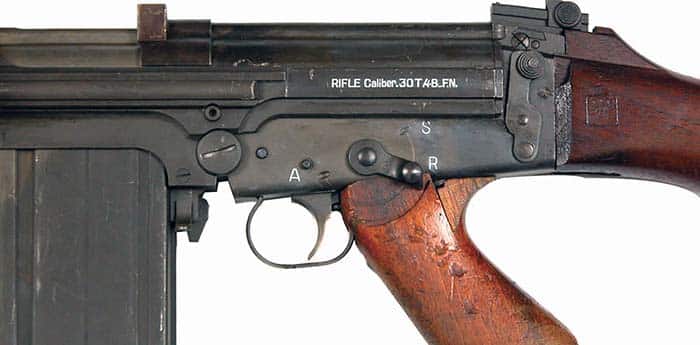
After the trials had been completed, Fort Benning reported that both rifles were suitable for army use, failing to decisively choose one design over the other. The Marine testing at Quantico slightly favored Springfield Armory’s T44E4. It seemed that no one was prepared to select one rifle over the other, as it was becoming a very sensitive political issue. Others were outspoken about the adoption of either rifle, stating that neither one represented any real improvements over the old M1 rifle and emphasizing that the search for a truly modern, lightweight infantry rifle simply had not been realized.
Nearly a year after the final trials, the U.S. Government finally concluded that the T44E4 was a full pound lighter than the T48, contained fewer parts and had a single-port gas system that didn’t require adjustments. The similarities between the T44E4 and the M1 Garand rifle would ease both training and manufacturing requirements. Despite pressure from the other NATO countries for the U.S. to adopt the Belgian-designed T48 rifle, on May 1, 1957, Secretary of the Army Wilbur H. Bruckner announced that the T44E4 and T44E5 were being adopted as the Standard U.S. service rifles as the M14 and M15 respectively. An Ordnance Committee meeting held on November 14, 1957, finalized the adoption of the M14 and the heavy-barrel M15 rifles as Standard. At the same meeting the M1 rifle, the Browning automatic rifle, the M1 carbine and the M3A1 submachine gun were classified as Limited Standard items.

With some reluctance from the European allies, the U.S.-developed 7.62x51mm T65E3 cartridge was officially adopted as the standard small arms round of the NATO alliance in 1954. Before long, many other allied countries began to seriously consider the FN FAL rifle. Being that most of the NATO countries had reluctantly adopted the U.S. cartridge, they expected the U.S. to also adopt the FN FAL rifle so that not only would NATO have a common cartridge but a common service rifle as well. However, there was no NATO requirement established for a standard infantry rifle; each country was free to adopt whatever rifle it wished.
The Belgian FAL rifle, in slightly varying configurations, was adopted as the standard service rifle by over 90 countries. The FN FAL would become the most prolific rifle among the NATO alliance. The U.S. M14 rifle would have one of the most short-lived tenures of any previous U.S. service rifle. Within a few years, after the last M14 rifle was made, the weapon began being phased out of U.S. service to be replaced by the small caliber 5.56mm M16 rifle. Many of the NATO alliance countries were somewhat bewildered by the United States’ decision to adopt the diminutive 5.56mm cartridge. Great Britain was stunned in light of the U.S. handily rejecting their .280 caliber cartridge back in 1954 on the grounds that it did not have sufficient power for a U.S. infantry weapon.
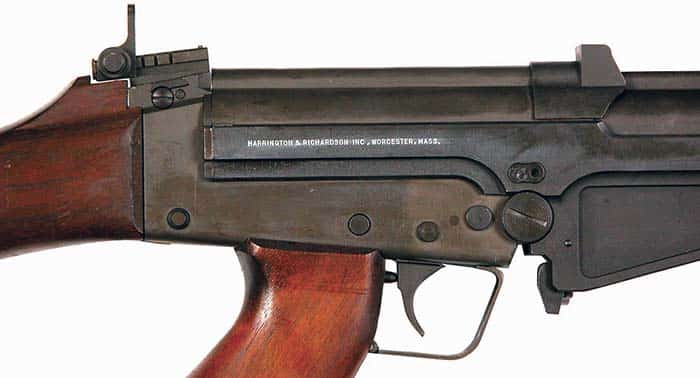
Where Are They Now?
The T48 rifles now repose in several U.S. military storage depots, many never fired. Most are the T48 rifles that were made by Harrington and Richardson. There are, however, more High Standard T48s made than have been reported in the past. There are seven standard barrel T48s and six heavy-barrel T48E1 rifles in storage at the Springfield Armory National Historic Site in Massachusetts. Although most of the T48 rifles were produced in a semiautomatic configuration, they do have a full-automatic capability and as such are considered machine guns. There are at least two documented original NFA-registered T48 rifles in private collections.
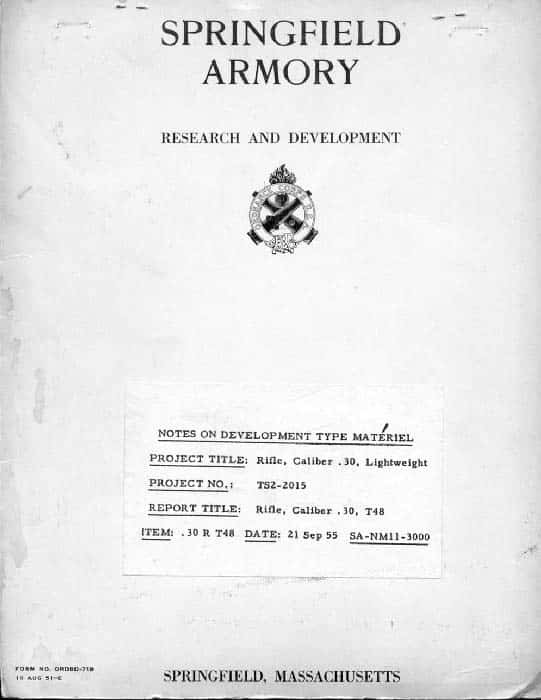
This article first appeared in Small Arms Review V22N9 (November 2018)












